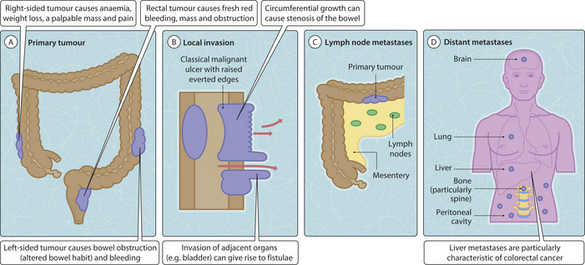Chapter 28 Colorectal cancer
Aetiological factors
Genetic and environmental factors contribute to the development of colorectal cancer. Around 25% of cases show ‘familial clustering’ but less than 5% occur in association with a clearly identifiable genetic mutation (Table 3.28.1). A low-residue ‘Western’ diet is thought to increase the risk of colorectal cancer by increasing bowel content transit time.
Almost all colorectal carcinomas develop from precursor lesions termed adenomas. Colonic adenomas are polypoid or flat lesions in which the epithelium shows variable degrees of dysplasia. The development of adenomas from normal mucosa and their subsequent progression to malignant invasion is termed the adenoma–carcinoma sequence (Chs 22 and 33).
Clinical presentation
As with all malignant tumours, patients with colorectal carcinoma may present with symptoms caused by the primary tumour, the metastases or the general features of malignancy (Fig. 3.28.1). Carcinomas may appear to the naked eye as polyps, malignant ulcers (i.e. with rolled everted edges) or areas of stricture formation (i.e. wall thickening with bowel lumenal narrowing). Typical effects of a primary tumour are change in bowel habit, rectal bleeding and/or mucus, anaemia, abdominal mass, bowel obstruction/perforation and fistula formation. Metastases cause jaundice (colorectal carcinoma is a relatively common cause of liver metastases, which can present before the primary tumour is identified, for example with jaundice), cerebral disturbance (brain metastases) and bone pain (skeletal metastases). In addition, there will be the general features of malignancy: tiredness, weight loss, anorexia and anaemia. Although anaemia can occur through chronic haemorrhage from small and large intestinal tumours or from the general effects of advanced malignancy, it is a particularly common (and often the only) feature of malignancy occurring within the caecum and ascending colon. Bowel perforation or acute obstruction are surgical emergencies in which the patient usually presents acutely unwell and commonly with the clinical features of an ‘acute abdomen’.
< div class='tao-gold-member'>
Stay updated, free articles. Join our Telegram channel

Full access? Get Clinical Tree









